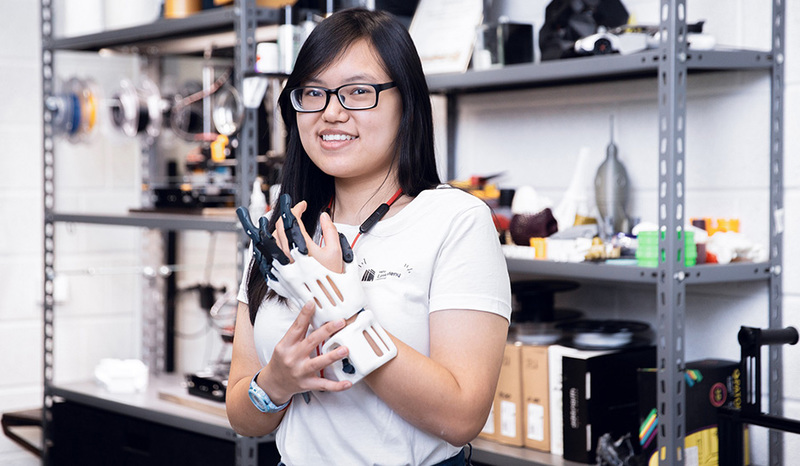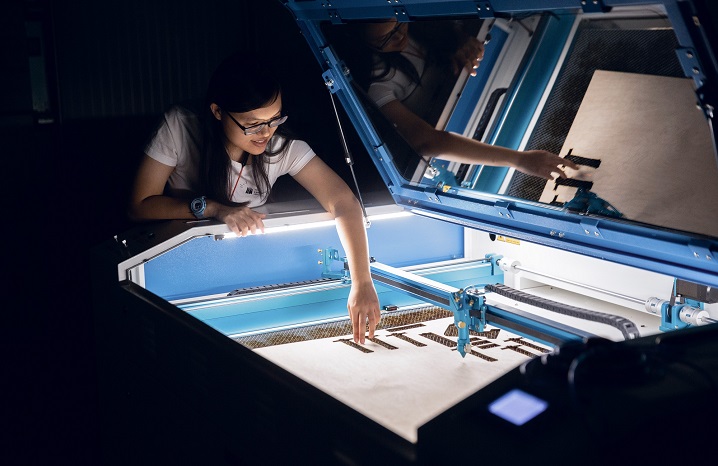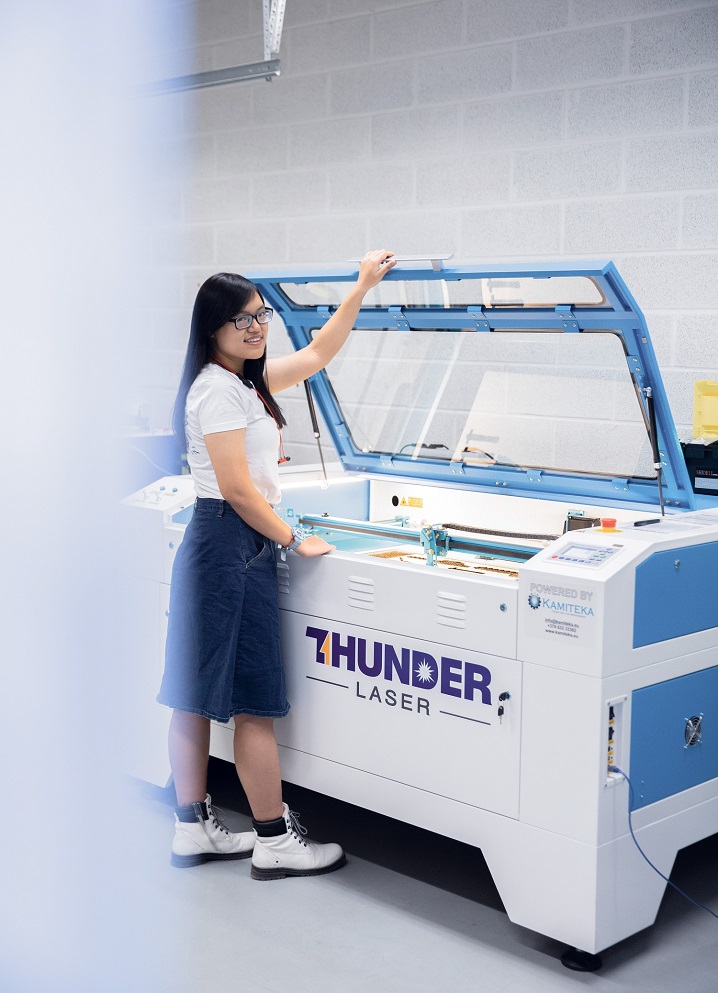The Centre of information technology and systems
About us
News
Young engineer from Malaysia challenged herself for an internship in Lithuania

2020-01-29
Young engineer from Malaysia challenged herself for an internship in Lithuania
When we think about sunny, tropical Malaysia, it’s hard to imagine why anyone would want to swap 26-degree Celsius for rainy and cloudy Vilnius. Not so for Xin Jo who’s driven by her passion for tech. She decided to leave her comfort zone and travel more than 8,000 kilometres to VGTU’s "LinkMenų fabrikas."
Xin Jo is a 23 year-old student from Universiti Teknologi Malaysia (UTM). At the moment, she’s pursuing a bachelor's degree in Civil Engineering. During her internship at VGTU "LinkMenų fabrikas", Xin Jo has been showing off her growing repertoire of skills - from 3D modelling, graphic design to coding. She’s here for a few days more until her flight leaves for Malaysia, so I met up with her and asked her about her time as a trainee with us.
What led you to choose Lithuania and VGTU "LinkMenų fabrikas" for your internship?
My passion is tech and as a trainee I’m still at the stage of 'trying new stuff'. All those engineering tools and tech available in VGTU "LinkMenų fabrikas" is what made me want to come here. Also, the other main reason is that Erasmus+ fully funds my program, which is almost too good to be true, for a student like me from a middle-class family.

Nowadays, tech industries attract more and more women. Why did you choose to study Civil Engineering?
My initial intention to study Civil Engineering is straightforward. It could provide me with job security for a long period of time. Regardless of how the world is changing people will always need to have a roof over their head. More houses need to be built to accommodate the growing population. But, the more I dived into Civil Engineering I began to view the construction industry from a sustainability point of view.
I like the quote from Peter Thiel's book, "Zero to One" – "there is nothing such as the developed world or nation. If every one of India's hundreds of millions of household were to live the way Americans already do - using only today's tools - the results would be environmentally catastrophic”.
In terms of sustainability you can see that huge progress is being made in the energy and automotive sectors such as solar-powered city and electric vehicles. However, in the construction industry, despite being one of the essential areas in making the world a better place, progress is less visible. The industry is notorious for its incrementally low rate over the last 20 years, and that’s mostly due to the lack of digitization.
Personally, I sense a huge opportunity if we combine the construction industry and the tech industry, especially from a sustainability point of view. That’s why I braved the unknown and took a risk by taking one semester off from my study and exposing myself to tech industries.
What was your learning journey in "LinkMenų fabrikas"?
I started with 3D Printing – first, by printing some functional decorative items for the 3D Printing workshop in "LinkMenų fabrikas". Later, I began to design my models using SolidWorks. Then, I was also given the opportunity to model the building of "LinkMenų fabrikas" from architectural drawings, and with the 3D printer actually print a mini model.
During the Christmas period I designed two prototypes for Christmas gifts. Both are produced using only 3D Printing. Then, it was suggested that I try the laser cutter to create some other prototypes. So, I designed six coasters using Inkscape and manufactured them using laser cutting and engraving. To make the prototypes look even more attractive I used a paint spray gun on the wooden coasters and also learned how to sand some of their parts. It was from this Christmas project that I accidentally learned how to use a laser cutter, paint sprayer and sanding plywood.
Currently, I am learning to set up the 3D printer control software, called OctoPi, to record time lapses of 3D Printing using a Raspberry Pi microcomputer and Raspberry camera. Although I’ve got some background in coding for Android apps and Arduino microcontrollers, this is the first time I’ve worked with Raspberry Pi. Fortunately, with the help of another intern, Gustavo, who comes from Brazil, I was quick to pick it up. Right now, the system is set up but will need to undergo some tests to find the balance point between the quality of 3D print and the video quality of the timelapse.

Blitz questions:
What was the biggest challenge you faced during your internship?
I would say time. Since time is limited I always push myself harder to work longer hours so that I can learn and gain more from the process. Yet, I still couldn’t do everything on my ‘want to learn list, like making my laser cutter machine, and getting involved in AR/VR development and video editing.
What is your favourite tool in VGTU "LinkMenų fabrikas"?
The large 600mm x 600mm x 600mm 3D printer. It’s definitely the ultimate experience that I could have here!
How do you think the skills you’ve gained here will contribute to your future career?
Technically I won't be able to use these skills in my future career. But I am sure that the fundamental knowledge and analogies obtained from learning these skills are going to be beneficial for my future learning curve and career. For example, in future I might not be using a 3D printer, but having the fundamental knowledge behind it – such as factors affecting the print quality, its mechanism – would help me to think of the 3D printing housing solution more critically.
Would you recommend others to take part in our intern program at VGTU’s "LinkMenų fabrikas"?
Yes! "LinkMenų fabrikas" offers lots of learning opportunities for interns. They don’t limit you to learn in a very structured way. You can plan your learning module on your own, and they will assign mentors to guide you. The people here are friendly, helpful and most importantly, talented. You can find electrical engineers, metal engineers, designers, video makers and many more, all in one place. So, it’s undoubtedly a good place to gain not only one but a lot of new skills.
Xin Jo is a 23 year-old student from Universiti Teknologi Malaysia (UTM). At the moment, she’s pursuing a bachelor's degree in Civil Engineering. During her internship at VGTU "LinkMenų fabrikas", Xin Jo has been showing off her growing repertoire of skills - from 3D modelling, graphic design to coding. She’s here for a few days more until her flight leaves for Malaysia, so I met up with her and asked her about her time as a trainee with us.
What led you to choose Lithuania and VGTU "LinkMenų fabrikas" for your internship?
My passion is tech and as a trainee I’m still at the stage of 'trying new stuff'. All those engineering tools and tech available in VGTU "LinkMenų fabrikas" is what made me want to come here. Also, the other main reason is that Erasmus+ fully funds my program, which is almost too good to be true, for a student like me from a middle-class family.

Nowadays, tech industries attract more and more women. Why did you choose to study Civil Engineering?
My initial intention to study Civil Engineering is straightforward. It could provide me with job security for a long period of time. Regardless of how the world is changing people will always need to have a roof over their head. More houses need to be built to accommodate the growing population. But, the more I dived into Civil Engineering I began to view the construction industry from a sustainability point of view.
I like the quote from Peter Thiel's book, "Zero to One" – "there is nothing such as the developed world or nation. If every one of India's hundreds of millions of household were to live the way Americans already do - using only today's tools - the results would be environmentally catastrophic”.
In terms of sustainability you can see that huge progress is being made in the energy and automotive sectors such as solar-powered city and electric vehicles. However, in the construction industry, despite being one of the essential areas in making the world a better place, progress is less visible. The industry is notorious for its incrementally low rate over the last 20 years, and that’s mostly due to the lack of digitization.
Personally, I sense a huge opportunity if we combine the construction industry and the tech industry, especially from a sustainability point of view. That’s why I braved the unknown and took a risk by taking one semester off from my study and exposing myself to tech industries.
What was your learning journey in "LinkMenų fabrikas"?
I started with 3D Printing – first, by printing some functional decorative items for the 3D Printing workshop in "LinkMenų fabrikas". Later, I began to design my models using SolidWorks. Then, I was also given the opportunity to model the building of "LinkMenų fabrikas" from architectural drawings, and with the 3D printer actually print a mini model.
During the Christmas period I designed two prototypes for Christmas gifts. Both are produced using only 3D Printing. Then, it was suggested that I try the laser cutter to create some other prototypes. So, I designed six coasters using Inkscape and manufactured them using laser cutting and engraving. To make the prototypes look even more attractive I used a paint spray gun on the wooden coasters and also learned how to sand some of their parts. It was from this Christmas project that I accidentally learned how to use a laser cutter, paint sprayer and sanding plywood.
Currently, I am learning to set up the 3D printer control software, called OctoPi, to record time lapses of 3D Printing using a Raspberry Pi microcomputer and Raspberry camera. Although I’ve got some background in coding for Android apps and Arduino microcontrollers, this is the first time I’ve worked with Raspberry Pi. Fortunately, with the help of another intern, Gustavo, who comes from Brazil, I was quick to pick it up. Right now, the system is set up but will need to undergo some tests to find the balance point between the quality of 3D print and the video quality of the timelapse.

Blitz questions:
What was the biggest challenge you faced during your internship?
I would say time. Since time is limited I always push myself harder to work longer hours so that I can learn and gain more from the process. Yet, I still couldn’t do everything on my ‘want to learn list, like making my laser cutter machine, and getting involved in AR/VR development and video editing.
What is your favourite tool in VGTU "LinkMenų fabrikas"?
The large 600mm x 600mm x 600mm 3D printer. It’s definitely the ultimate experience that I could have here!
How do you think the skills you’ve gained here will contribute to your future career?
Technically I won't be able to use these skills in my future career. But I am sure that the fundamental knowledge and analogies obtained from learning these skills are going to be beneficial for my future learning curve and career. For example, in future I might not be using a 3D printer, but having the fundamental knowledge behind it – such as factors affecting the print quality, its mechanism – would help me to think of the 3D printing housing solution more critically.
Would you recommend others to take part in our intern program at VGTU’s "LinkMenų fabrikas"?
Yes! "LinkMenų fabrikas" offers lots of learning opportunities for interns. They don’t limit you to learn in a very structured way. You can plan your learning module on your own, and they will assign mentors to guide you. The people here are friendly, helpful and most importantly, talented. You can find electrical engineers, metal engineers, designers, video makers and many more, all in one place. So, it’s undoubtedly a good place to gain not only one but a lot of new skills.


